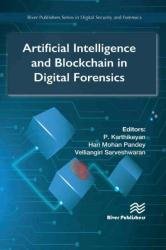Artificial Intelligence and Blockchain in Digital Forensics
- Добавил: literator
- Дата: 9-12-2022, 20:29
- Комментариев: 0
 Название: Artificial Intelligence and Blockchain in Digital Forensics
Название: Artificial Intelligence and Blockchain in Digital ForensicsАвтор: P. Karthikeyan, Hari Mohan Pandey, Velliangiri Sarveshwaran
Издательство: River Publishers/Routledge
Год: 2023
Страниц: 297
Язык: английский
Формат: pdf (true)
Размер: 24.3 MB
Digital forensics is the science of detecting evidence from digital media like a computer, smart phone, server, or network. It provides the forensic team with the most beneficial methods to solve confused digital-related cases. Artificial Intelligence (AI) and Blockchain can be applied to solve online predatory chat cases and photo forensics cases, provide network service evidence, custody of digital files in forensic medicine, and identify roots of data scavenging. The increased use of PCs and extensive use of internet access, has meant easy availability of hacking tools. Over the past two decades, improvements in the information technology landscape have made the collection, preservation, and analysis of digital evidence extremely important. The traditional tools for solving cybercrimes and preparing court cases are making investigations difficult. We can use AI and blockchain design frameworks to make the digital forensic process efficient and straightforward. AI features help determine the contents of a picture, detect spam email messages and recognize swatches of hard drives that could contain suspicious files. Blockchain-based lawful evidence management schemes can supervise the entire evidence flow of all of the court data.
Deep Learning is an essential part of Data Science because it supports predictive analytics and allows data scientists to rapidly and cheaply gather, organize, analyze, and understand massive quantities of data. After analyzing AI and Deep Learning algorithms’ capacity to observe and anticipate human behavior, one important element that impacts the quality of the algorithm’s outputs is the number of datasets on which the deep learning models are trained. The more data there is and the higher the quality, the more accurate and trustworthy the results will be. Recurrent neural networks (RNNs) are a type of neural network that may be used to represent sequence data. RNNs, derived from feedforward networks, behave in the same way as human brains.
Digital Forensics (DF) is an area that is turning out to be progressively signifcant in collecting a lot of computationally large and complex information and frequently requires intelligent analysis throughout the globe. DF presents a method for carefully utilizing scientifc information to reveal and understand electronic evidence. Artifcial Intelligence (AI) techniques address challenges in digital forensics and give a method for handling computationally enormous or complex issues in a reasonable period. This chapter provides an overview of some of the AI principles and procedures. It features everyday diffculties, including the accessibility of data sets in a few regions and explicit trouble in clarifying the outcomes when specifc strategies are utilized. This chapter suggests that there is indeed a requirement to improve the utilization of the AI principles accessible and also discusses the strengths and constraints of currently used investigative technologies. This chapter also suggests the diffculties in delivering models where limited training information is induced from the models. Therefore, in this chapter, we have proposed a taxonomical framework with graphs and results to battle the current and analyze the future diffculties of DF.
This book can provide a wide-ranging overview of how AI and blockchain can be used to solve problems in digital forensics using advanced tools and applications available on the market.
Скачать Artificial Intelligence and Blockchain in Digital Forensics
[related-news] [/related-news]
Внимание
Уважаемый посетитель, Вы зашли на сайт как незарегистрированный пользователь.
Мы рекомендуем Вам зарегистрироваться либо войти на сайт под своим именем.
Уважаемый посетитель, Вы зашли на сайт как незарегистрированный пользователь.
Мы рекомендуем Вам зарегистрироваться либо войти на сайт под своим именем.
